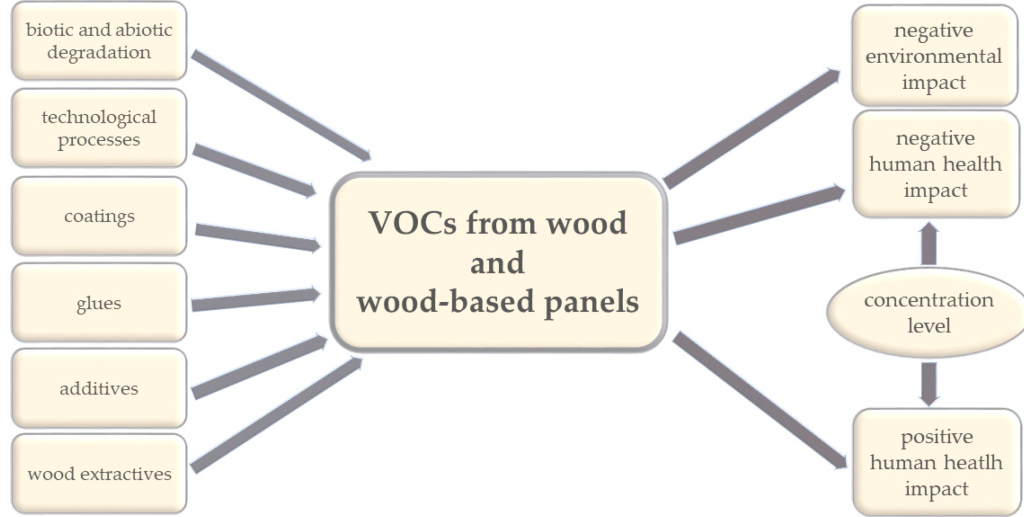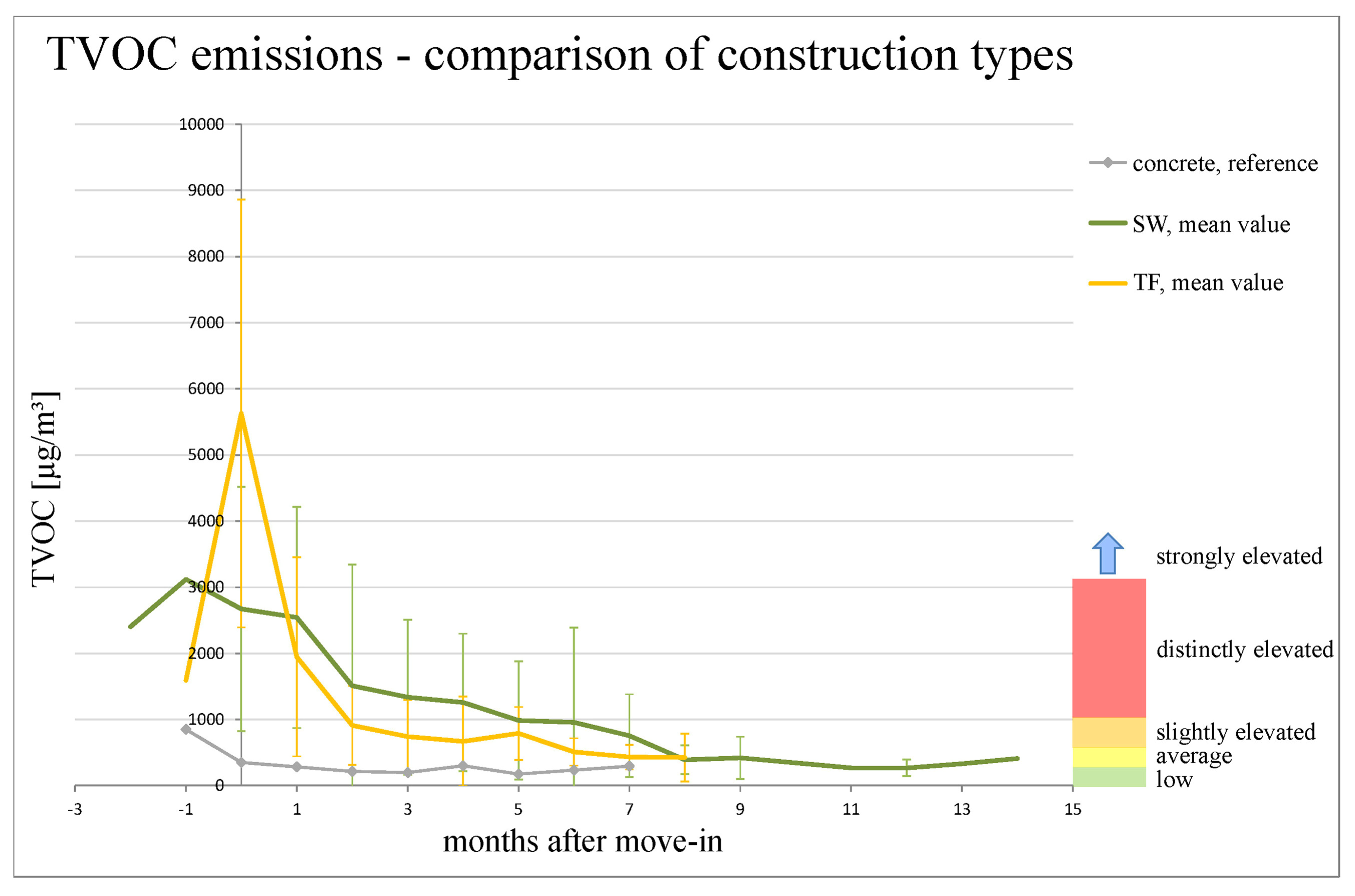Sustainable buildings made of wood with a good indoor climate and positive life cycle assessment, but what about air quality?
Wood is a building material that has become increasingly popular in recent years. This is due to many advantages that the natural raw material brings with it. Thanks to a high degree of prefabrication, construction projects can be realized quickly, and the low weight of the building material also brings some advantages. The building material is locally available in Europe and is also sustainable. Nevertheless, the connection between sustainability and a construction made of wood must be viewed critically, since various influencing factors, such as forestry, must be taken into account. Nevertheless, because of to the rethinking in terms of resource consumption, timber construction will become more and more important in the future and the usage will increase. In the following therefore, the building material timber will be considered with regard to the effects on indoor air quality, since there are currently still few regulations and statements on the health impact of wooden constructions.
Emissions caused by timber or wood-based material
To describe the air quality in wooden buildings, especially the VOCs are of great importance. VOCs, volatile organic compounds, are substances such as alcohols, aldehydes, ketones, ethers, acids from the group of carbonyl compounds or terpenes. Wood is composed of the three main components cellulose, hemicellulose and lignin as well as the extractives. The extractives make up only a very small proportion in wood but are responsible for VOC emissions and other specific properties. These pollutants are associated with negative effects on air quality. Thus, there may be negative effects on the health of building occupants, such as sick building syndrome (SBS). [1]
VOCs can be of natural or anthropogenic origin. Wood naturally contains terpenes. In the case of pine wood, terpenes account for 90 percent of TVOCs (sum of all VOCs). In addition to terpenes, aldehydes and acetic acid play a minor role for indoor air quality. In general, each wood species emits differently. It also depends on where the tree grew, and which part of the wood was tested (e.g. split-/ heartwood or juvenile/ adult wood). For the common species like pine and spruce is research data available, but for the conifers larch or Douglas fir there are hardly any reliable values. The increasingly important hardwoods are also poorly researched in terms of their emission behavior. [2]
Wooden buildings
In modern timber construction, there are precise processes for the treatment from wood to timber. Due to cost, usability and material savings, solid wood is rarely used, but rather various wood-based materials. For ceilings for example, cross-laminated timber panels (CLT) are usually installed, beams can be built out of solid wood or glulam and there are many other products on the market.
The following figure describes the composition of various wood-based materials and the connection with several health effects. The wood-based materials such as cross-laminated timber (CLT), oriented-strand board (OSB), chipboard panels and many other products show a different emission behavior because they are often mixed with flame retardants, hardeners and adhesives (usually UF, MF, PF and PMDI).

Conclusion
Emission behavior of wood and wood-based materials is investigated by several studies due to their relevance for human health. The following figure shows the TVOC concentration over time. At the time of installation, the TVOC concentration is strongly increased. After approximately eight months, the emissions equal to a value obtained in a conventional reinforced concrete structure. The study also distinguished between timber-frame (TF) and solid wood (SF) construction types, as the installation situation can mean large differences in indoor air quality.

Various measurements have shown that primary emissions, such as terpenes, exhibit a rapid decay behavior. Secondary emissions (in wood mainly from aldehydes), however, increase in part at the beginning of the installation and subside only after several weeks. Controlled ventilation can also reduce emissions by almost half compared to manual ventilation. For environmental and energetic reasons, buildings are now being built much more tightly than in the past. And due to the good thermal properties, wooden buildings are usually very tight and fulfill even the highest tightness requirements. [3]
Even though building with wood becomes more and more popular, there is still a lack of scientific research and standardized limit values for air quality in wooden buildings. The emission behavior has been researched in principle, but as described above, it varies greatly. In general, the installation situation must always be taken into account. [2]
Several independent studies have shown that thermal treatment of wood can reduce VOC emissions. It also accelerates the decay of emissions. With a proper drying process, wood can generally be considered as a harmless material for indoor use. In the coming years, manufacturers of wood-based materials will be expected to provide reliable information on their products. As already mentioned, the emisson behavior of a natural building material depends on many factors and should be investigated by each manufacturer on a product-specific basis and generally regulated by official requirements.
References:
[1] Adamová, T.; Hradecký, J.; Pánek, M. (2020): Volatile Organic Compounds (VOCs) from Wood and Wood-Based Panels: Methods for Evaluation, Potential Health Risks, and Mitigation, DOI:10.3390/polym12102289 [2] Butter K, Ohlmeyer M (2021) Emissionen flüchtiger organischer Verbindungen von Holz und Holzwerkstoffen. Braunschweig: Johann Heinrich von Thünen-Institut, 102p, Thünen Rep 86, DOI:10.3220/REP1622449526000 [3] Fürhapper, C.; Habla, E.; Stratev, D.; Weigl, M.; Dobianer, K. (2020): Living Conditions in Timber Houses: Emission Trend and Indoor Air Quality, DOI:10.3389/fbuil.2019.00151